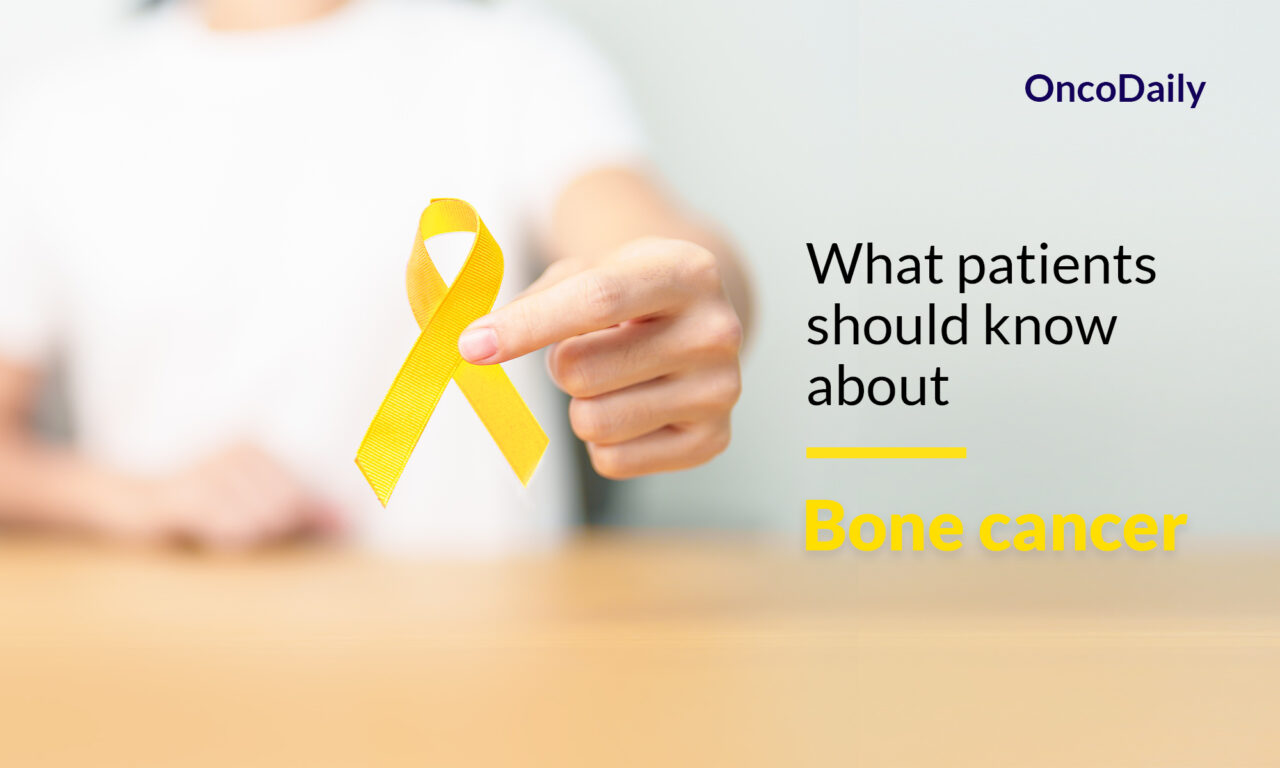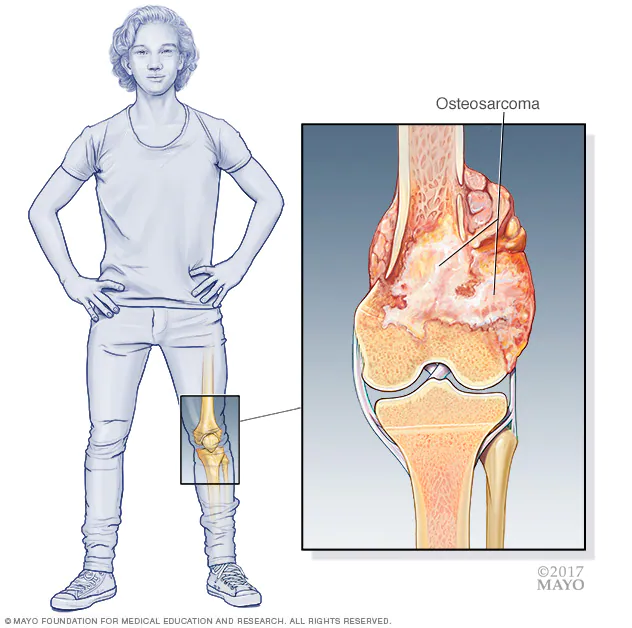
Bone cancer: What patients should know about
Introduction
Bone cancer is a rare type of cancer that begins in the bones. It can be classified into two main types: primary bone cancer and secondary bone cancer. Primary bone cancer starts in the bone itself, while secondary bone cancer, also known as metastatic bone cancer, occurs when cancer cells spread to the bones from another part of the body.
Causes and Risk Factors
The exact cause of bone cancer is not well understood, but several risk factors have been identified:
Age
Bone cancer is more common in children, teenagers, and young adults whose bones are still growing. Osteosarcoma, for example, is more common in adolescents and young adults, while chondrosarcoma tends to occur in middle-aged and older adults.
Previous Cancer Treatments
People who have had radiation therapy or chemotherapy for other cancers are at a higher risk of developing bone cancer. This is especially true for those who received high doses of radiation at a young age or were treated with certain types of chemotherapy drugs.
Genetic Factors
Certain genetic conditions can increase the risk of bone cancer. For instance, Li-Fraumeni syndrome and hereditary retinoblastoma are linked to a higher risk of developing bone cancer. These genetic changes are passed down in families and can significantly increase the likelihood of cancer.
Bone Diseases
Conditions like Paget’s disease of the bone can increase the risk of bone cancer, particularly in older adults. Paget’s disease causes abnormal bone tissue to form, leading to brittle and thick bones that are more likely to break and potentially develop into cancer.
Bone or Cartilage Tumors
Having certain types of benign bone or cartilage tumors can increase the risk of bone cancer. For example, people with multiple osteochondromas or enchondromas have a higher risk of developing chondrosarcoma.
Bone Marrow Transplant
In rare cases, having a bone marrow transplant has been linked to the development of osteosarcoma.
Bone Cancer Subtypes
There are several types of primary bone cancer, each affecting different types of cells within the bone:
Osteosarcoma – Osteosarcoma is the most common type of bone cancer, usually affecting the long bones in the arms and legs. It often occurs in teenagers and young adults and is known for its aggressive nature.
Chondrosarcoma – Chondrosarcoma develops in the cartilage cells and is more common in adults. It typically affects the pelvis, legs, and arms and can vary in its level of aggressiveness.
Ewing Sarcoma – Ewing sarcoma often starts in the bones but can also form in the soft tissues around the bones. It mostly affects children and teenagers and is known for its rapid growth and potential to spread.
Chordoma – Chordoma is a rare type of bone cancer that occurs in the bones of the spine and the base of the skull. It tends to grow slowly but can be challenging to treat due to its location.

This image is taken from mayoclinic.org
Symptoms
Symptoms of bone cancer can vary depending on the size and location of the tumor. Common symptoms include:
Pain – Persistent bone pain that worsens over time and is often worse at night. This occurs because the tumor puts pressure on the bone and surrounding tissues.
Swelling and Redness – Inflammation over the affected bone, making movement difficult if near a joint. This is due to the body’s response to the tumor, which can cause swelling and redness in the area.
Lump – A noticeable lump over the bone. This lump is the tumor itself, which can sometimes be felt through the skin.
Fractures – Weakened bones that break more easily. The tumor can weaken the bone structure, making it more susceptible to fractures even with minor injuries.
Fatigue and Weight Loss – General symptoms that can occur with many types of cancer. The body’s energy is often diverted to fighting the cancer, leading to fatigue and unintentional weight loss.

This image is taken from quora.com
Diagnosis
Diagnosing bone cancer typically involves several steps:
- Medical History and Physical Exam
A thorough medical history and physical examination to check for signs of bone cancer. This helps in understanding the patient’s symptoms and any potential risk factors.
- Imaging Tests
Imaging tests such as X-rays, MRI, CT scans, PET scans, and bone scans are used to visualize the tumor and determine its size and location. These tests provide detailed images of the bone and surrounding tissues.
- Biopsy
A sample of tissue is taken from the tumor to confirm the diagnosis and determine the type of bone cancer. This can be done through a needle biopsy or a surgical biopsy, where a small piece of the tumor is removed for examination under a microscope.
Prognosis
The prognosis for bone cancer depends on several factors, including the type and stage of cancer, the size and location of the tumor, and the patient’s age and overall health. Generally, bone cancer is easier to treat if it is detected early and has not spread to other parts of the body.
Treatment and Side Effects
Treatment for bone cancer often involves a combination of surgery, chemotherapy, and radiation therapy, depending on the type and stage of the cancer.
Surgery
The primary goal of surgery is to remove the entire tumor and some surrounding healthy tissue. Limb-sparing surgery is often possible for many types of bone cancer, allowing the affected limb to be preserved. However, in some cases, amputation may be necessary, particularly if the tumor has spread extensively or is located in an area where limb-sparing surgery is not feasible.
The type of surgery depends on the size and location of the tumor, as well as the specific type of bone cancer. For example:
- Osteosarcoma: Limb-sparing surgery is commonly performed, with the affected bone section replaced by a metal implant (prosthesis) or a bone graft.
- Chondrosarcoma: Surgery may involve removing the tumor and reconstructing the affected bone with a graft or prosthesis.
- Ewing Sarcoma: Limb-sparing surgery is often possible, but amputation may be necessary in some cases.
Chemotherapy
Chemotherapy is an essential part of treatment for certain types of bone cancer, such as osteosarcoma and Ewing sarcoma. It involves using powerful drugs to kill cancer cells throughout the body. Chemotherapy may be given:
- Before surgery (neoadjuvant): To shrink the tumor and make it easier to remove.
- After surgery (adjuvant): To kill any remaining cancer cells and reduce the risk of recurrence.
Common side effects of chemotherapy include nausea, fatigue, hair loss, increased risk of infections, and low blood cell counts. The specific side effects can vary depending on the drugs used and the individual’s response to treatment.
Radiation Therapy
Radiation therapy uses high-energy beams to kill cancer cells. It is often used in combination with other treatments for bone cancer, such as:
- Before surgery: To shrink the tumor and make it easier to remove.
- After surgery: To target any remaining cancer cells and reduce the risk of recurrence.
- For inoperable tumors: To control tumor growth and relieve symptoms when surgery is not an option.
Side effects of radiation therapy can include skin irritation, fatigue, nausea (if treating the abdomen or pelvis), and an increased risk of fractures in the treated bone.
Mifamurtide
For patients with high-grade, non-metastatic osteosarcoma, a medicine called mifamurtide may be used alongside other treatments. Mifamurtide is a drug that stimulates the immune system to produce specialized cells (macrophages) that can kill cancer cells.
Mifamurtide is typically recommended for children, adolescents, and young adults with osteosarcoma. It is given after surgery, in combination with chemotherapy, to help prevent the cancer from returning or spreading.
Common side effects of mifamurtide include fever, chills, headache, nausea, and muscle aches.
Newest Options and Ongoing Clinical Trials
Research is ongoing to find new and better ways to treat bone cancer. Some of the latest advancements include:
Targeted Therapy
Targeted therapy involves drugs that target specific genetic changes or molecular pathways in cancer cells. These drugs can block the growth and spread of cancer by interfering with specific molecules involved in tumor growth. Examples of targeted drugs used for some types of bone cancer include imatinib, dasatinib, and sunitinib.
Immunotherapy
Immunotherapy treatments help boost the body’s natural defenses to recognize and attack cancer cells more effectively. Different types of immunotherapy, such as immune checkpoint inhibitors, monoclonal antibodies, and adoptive cell transfer, are being explored for the treatment of bone cancers.
Clinical trials are ongoing to evaluate the effectiveness of these newer treatments, either alone or in combination with other therapies, for various types of bone cancer.
It’s important to note that the choice of treatment depends on several factors, including the type and stage of bone cancer, the patient’s age, overall health, and personal preferences. Patients should discuss all available treatment options, potential side effects, and ongoing clinical trials with their healthcare team to make an informed decision.
More information about ongoing clinical trials can be found on clinicaltrials.gov
Patient Survivorship
Surviving bone cancer can bring its own set of challenges. Survivors may face physical, emotional, and social issues, including:
Physical Effects
Long-term side effects from treatment, such as fatigue, pain, and mobility issues. These can result from surgery, chemotherapy, or radiation therapy and may require ongoing management.
Emotional Impact
Anxiety, depression, and fear of recurrence are common among cancer survivors. The emotional toll of cancer and its treatment can be significant, and support from mental health professionals may be beneficial.
Social Challenges
Difficulty returning to work or school and changes in relationships. Cancer treatment can disrupt daily life, and survivors may need support to reintegrate into their normal routines.
Follow-Up Care
Regular follow-up appointments are essential to monitor for any signs of cancer recurrence and manage any long-term side effects of treatment. Survivorship care plans can help address these issues and improve the quality of life for bone cancer survivors.
Lifestyle Changes
Adopting a healthy lifestyle can help improve overall well-being and reduce the risk of cancer recurrence. This includes maintaining a healthy weight, staying physically active, eating a balanced diet, and avoiding tobacco and excessive alcohol consumption.
Support Groups
Joining support groups can provide emotional support and practical advice from others who have experienced similar challenges. These groups can be a valuable resource for coping with the aftermath of cancer treatment.
This fascinating video is taken from Columbus Ledger-Enquirer
Conclusion
Bone cancer is a rare but serious condition that requires prompt and effective treatment. Understanding the causes, risk factors, symptoms, and treatment options can help patients and their families navigate the challenges of this disease.
With ongoing research and advancements in treatment, the outlook for bone cancer patients continues to improve. Survivorship care is also crucial in addressing the long-term effects of cancer and its treatment, ensuring that survivors can lead fulfilling lives after their cancer journey.
Resources
- American Family Physician – aafp.org
- Bone cancer incidence by morphological subtype: a global assessment
- National Comprehensive Cancer Network – JNCCN
- American Society of Clinical Oncology – Cancer.Net
- American Cancer Society – cancer.org
- National Cancer Institute – cancer.gov
- Osteosarcoma: a comprehensive review – PubMed
- Systematic Review of Recurrent Osteosarcoma Systemic Therapy – PubMed
- Osteosarcoma: A comprehensive review of management and treatment strategies – PubMed
- Bone Cancer: Diagnosis and Treatment Principles – PubMed
- Systematic Review of Recurrent Osteosarcoma Systemic Therapy – PubMed
